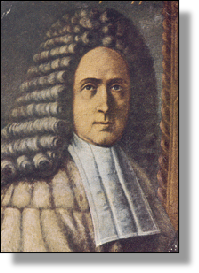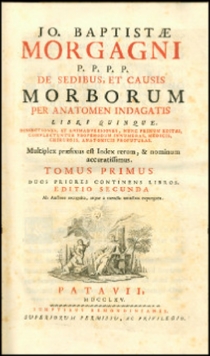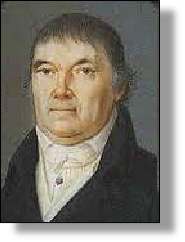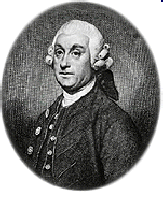


GIOVANNI BATTISTA MORGAGNI 1682 -
xxxxxThe Italian physician Giovanni Battista Morgagni was appointed professor of anatomy at Padua University in 1715. He carried out some 700 post mortems, and during these operations he studied the connection between particular diseases and the physical changes occurring in certain organs. Based on these findings, his treatise On the Seats and Causes of Diseases, published in 1761, laid the foundations for the branch of science known as pathological anatomy. This work dealt especially with those diseases associated with the heart, lungs and liver, but he also studied other parts of the body, including the brain.
 xxxxxThe physician Giovanni Battista Morgagni was born in Forli, northern Italy, and studied medicine and philosophy at Bologna. After graduating in 1701, he spent some time assisting his fellow countryman, the anatomist Antonio Maria Valsalva (1666-
xxxxxThe physician Giovanni Battista Morgagni was born in Forli, northern Italy, and studied medicine and philosophy at Bologna. After graduating in 1701, he spent some time assisting his fellow countryman, the anatomist Antonio Maria Valsalva (1666-
xxxxxIn 1710 he was appointed professor of medicine at Padua University, and five years later was promoted to the chair of anatomy. It was here, in the process of conducting some 700 post mortems, that he came to make a close study of the connection between particular diseases and the physical changes occurring in certain organs. As a result, his major treatise, On the Seats and Causes of Diseases Investigated by Anatomy, produced in 1761, laid the foundations of the branch of science known as pathological anatomy. In particular, this work contained important data as to the effects of disease on three vital organs, the heart, liver and lungs. It covered, for example, ailments affecting the valves of the heart, cirrhosis of the liver, and the congestion of the lungs.
certain organs. As a result, his major treatise, On the Seats and Causes of Diseases Investigated by Anatomy, produced in 1761, laid the foundations of the branch of science known as pathological anatomy. In particular, this work contained important data as to the effects of disease on three vital organs, the heart, liver and lungs. It covered, for example, ailments affecting the valves of the heart, cirrhosis of the liver, and the congestion of the lungs.
xxxxxAn earlier work by Morgagni, his Adversaria Anatomica, completed in 1719, had already established him as a competent anatomist. He was, for example, the first anatomist to discover that in cases where paralysis has affected one side of the body, the lesion responsible is situated on the opposite side of the brain. And his research also extended knowledge relating to the male urethra, the female genitals, and the glands of the windpipe.
Acknowledgements
Morgagni: date and artist unknown. Mesmer: miniature portrait by the German artist Joseph Einsle (1794-
G3a-
Including:
Franz Anton
Mesmer

xxxxxIn 1775 the Austrian physician Franz Anton Mesmer (1734-
 xxxxxIt was just a few years after the publication of Morgagni's major work in 1761 that the Austrian physician, Franz Anton Mesmer (1734-
xxxxxIt was just a few years after the publication of Morgagni's major work in 1761 that the Austrian physician, Franz Anton Mesmer (1734-
 xxxxxAs one might imagine, such a method, bordering as it did on the occult, caused a stir, particularly among the medical fraternity. The physicians of Vienna, where Mesmer happened to be living at the time, accused him of being a fraud and drove him out of the city. He settled in Paris in 1778, and here he made a very comfortable living, despite protests from the local medical profession. Eventually, however, in 1784 King Louis XVI appointed a commission of physicians and scientists to investigate "mesmerism". This august body, which included the French chemist Antoine-
xxxxxAs one might imagine, such a method, bordering as it did on the occult, caused a stir, particularly among the medical fraternity. The physicians of Vienna, where Mesmer happened to be living at the time, accused him of being a fraud and drove him out of the city. He settled in Paris in 1778, and here he made a very comfortable living, despite protests from the local medical profession. Eventually, however, in 1784 King Louis XVI appointed a commission of physicians and scientists to investigate "mesmerism". This august body, which included the French chemist Antoine-
xxxxxMesmer was doubtless a charlatan, and his "treatment" could be harmful to say the least. Some of his patients whom he managed to "mesmerise" ended up having convulsions or fits of delusion. Thisxsaid, others did find the treatment of some value -

xxxxxIncidentally, in England during this period one of the most distinguished physicists of the day was Percivall Pott (1714-


